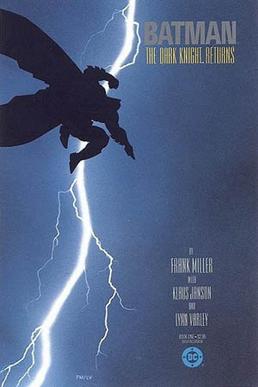
The Dark Knight Returns is a 1986 four-issue comic book miniseries starring Batman, written by Frank Miller, illustrated by Miller and Klaus Janson, with color by Lynn Varley, and published by DC Comics. It tells an alternative story of Bruce Wayne, who at 55 years old returns from a decade of retirement to fight crime while facing opposition from the Gotham City police force and the United States government. The story also features the return of classic foes Two-Face and the Joker, and culminates in a confrontation with Superman, who is now a pawn of the government.

The Joker is a supervillain appearing in American comic books published by DC Comics. Created by Bill Finger, Bob Kane, and Jerry Robinson, the character first appeared in the debut issue of the comic book Batman on April 25, 1940. Credit for the Joker's creation is disputed; Kane and Robinson claimed responsibility for his design while acknowledging Finger's writing contribution. Although the Joker was planned to be killed off during his initial appearance, he was spared by editorial intervention, allowing the character to endure as the archenemy of the superhero Batman.
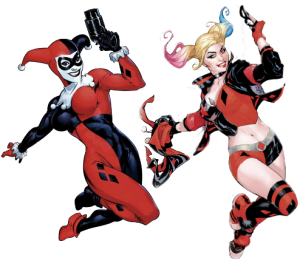
Harley Quinn is a character appearing in American comic books published by DC Comics. She was created by Paul Dini and Bruce Timm for Batman: The Animated Series as a henchwoman for the Joker, and debuted in its 22nd episode, "Joker's Favor", on September 11, 1992. While intended to appear in one episode, Quinn became a recurring character within the DC Animated Universe (DCAU) as the Joker's sidekick and love interest, and was adapted into DC Comics' canon seven years later, beginning with the one-shot Batman: Harley Quinn #1. Quinn's origin story features her as a former psychologist at Gotham City's Arkham Asylum who was manipulated by and fell in love with the Joker, her patient, eventually becoming his accomplice and lover. The character's alias is a play on the stock character Harlequin from the 16th-century Italian theater commedia dell'arte.
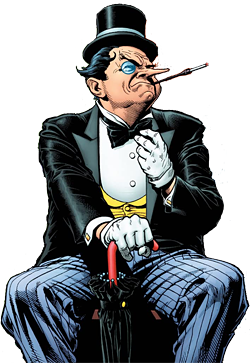
The Penguin is a supervillain appearing in American comic books published by DC Comics, commonly as an adversary of the superhero Batman. The character made his first appearance in Detective Comics #58 and was created by Bob Kane and Bill Finger. The Penguin is one of Batman's most enduring enemies and belongs to the collective of adversaries that make up Batman's rogues gallery.
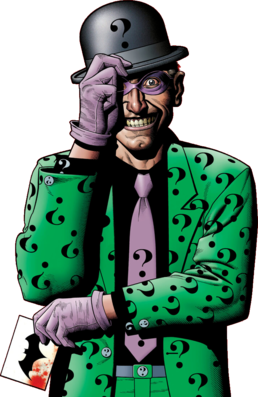
The Riddler is a supervillain appearing in American comic books published by DC Comics. The character was created by Bill Finger and Dick Sprang, and debuted in Detective Comics #140 in October 1948. He has become one of the most enduring enemies of the superhero Batman and belongs to the collective of adversaries that make up his rogues gallery.
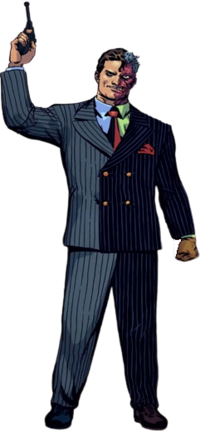
Two-Face is a supervillain appearing in comic books published by DC Comics, commonly as an adversary of the superhero Batman. The character was created by Bob Kane and first appeared in Detective Comics #66. As one of Batman's most enduring enemies, Two-Face belongs to the collective of adversaries that make up Batman's rogues gallery.

James W. "Jim" Gordon Sr. is a fictional character appearing in American comic books published by DC Comics, most commonly in association with the superhero Batman. Created by Bill Finger and Bob Kane as an ally of Batman, the character debuted in the first panel of Detective Comics #27, Batman's first appearance, making him the first Batman supporting character ever to be introduced.
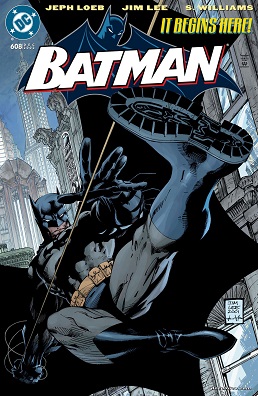
"Batman: Hush" is an American comic book story arc published by DC Comics featuring the superhero Batman. It was published in monthly installments within the comic book series Batman, running from issue #608–619 in October 2002 until September 2003. The story arc was written by Jeph Loeb, penciled by Jim Lee, inked by Scott Williams, and colored by Alex Sinclair, under the editorship of Bob Schreck.

The Ventriloquist is the name of multiple supervillains appearing in American comic books and other media published by DC Comics. All of the Ventriloquist's versions are enemies of Batman, belonging to the collective of adversaries that make up Batman's rogues gallery.

Black Mask is a supervillain appearing in comic books published by DC Comics. Created by Doug Moench and Tom Mandrake, the character debuted in Batman #386. He is commonly depicted as a brutal and ruthless crime lord in Gotham City who has a fixation with masks and derives sadistic pleasure from the act of torture. Black Mask is one of the most enduring enemies of the superhero Batman and belongs to the collective of adversaries that make up his rogues gallery.
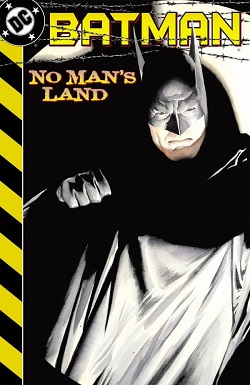
"Batman: No Man's Land" is an American comic book crossover storyline that ran for almost all of 1999 through the Batman comic book titles published by DC Comics. The story architecture for "No Man's Land" and the outline of all the Batman continuity titles for 1999 were written by cartoonist Jordan B. Gorfinkel.

Batman Black and White refers to the comic book limited series published by DC Comics featuring 8-page black and white Batman stories. Volumes 1, 4 and 5 of the series feature all-new stories, while Vol. 2 and 3 contain stories from the back-up feature of the Batman: Gotham Knights comic book.

"War Crimes" is a comic book crossover storyline published by DC Comics. The event ran during the month of August 2005 in the Batman and Detective Comics series, and is the sequel to another Batman crossover, War Games. While originally released by itself in trade paperback format, the later trade paperback release in 2016 would have this event as part of Batman: War Games Vol. 2.

Joker is an American graphic novel published by DC Comics in 2008. Written by Brian Azzarello and illustrated by Lee Bermejo, it is based on characters from DC's Batman series, focusing primarily on the title character. It is a unique take on the Batman mythos, set outside regular continuity and narrated by one of the Joker's henchmen. The miniseries Batman: Damned is a stand-alone sequel to the graphic novel, with the miniseries incorporating certain details, settings, and designs that hint at the two stories sharing a connected narrative.
Batman: Gotham County Line is a three-issue American comic book limited series written by Steve Niles, known for his series 30 Days of Night, and illustrated by Scott Hampton. It follows Batman as a series of ritual murders outside Gotham City leads him into a macabre supernatural realm.

"Batman: Death of the Family" is a 23-issue comic book story arc first published by DC Comics in 2012 featuring the fictional superhero Batman and his family of supporting characters. The arc spans several titles featuring characters of the Batman family including: Batman, Batgirl, Batman and Robin, Catwoman, Detective Comics, Nightwing, Red Hood and the Outlaws, Suicide Squad, and Teen Titans. The story involves the return of Batman's archenemy, the Joker, and his plan to destroy all of the people Batman has come to rely on over the years: the multiple Robins, Batgirl, Catwoman, Alfred Pennyworth, and Commissioner James Gordon. The title is a reference to the classic Batman story arc "A Death in the Family" (1988), in which the Joker murders Jason Todd.
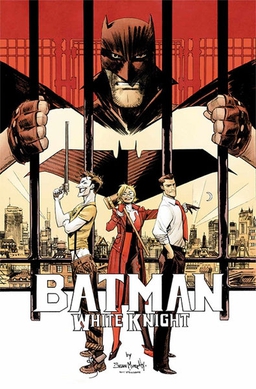
Batman: White Knight is an American comic book published by DC Comics. The eight-issue limited series, written and illustrated by Sean Murphy, began monthly publication in October 2017 and concluded in May 2018. In the series, the Joker is seemingly cured of his madness and sets out to become a politician under his real name of Jack Napier, seeking to change his public image as a "villain" and save Gotham City from Batman, whom he views as the real enemy of the city.
"The Joker War" is a comic book crossover storyline published by DC Comics in late 2020, featuring Batman and his allies. Primarily written by James Tynion IV, the arc is his first major arc on Batman in DC Rebirth. The main story was from Batman #95–100, while 16 other issues were tie-ins.
















